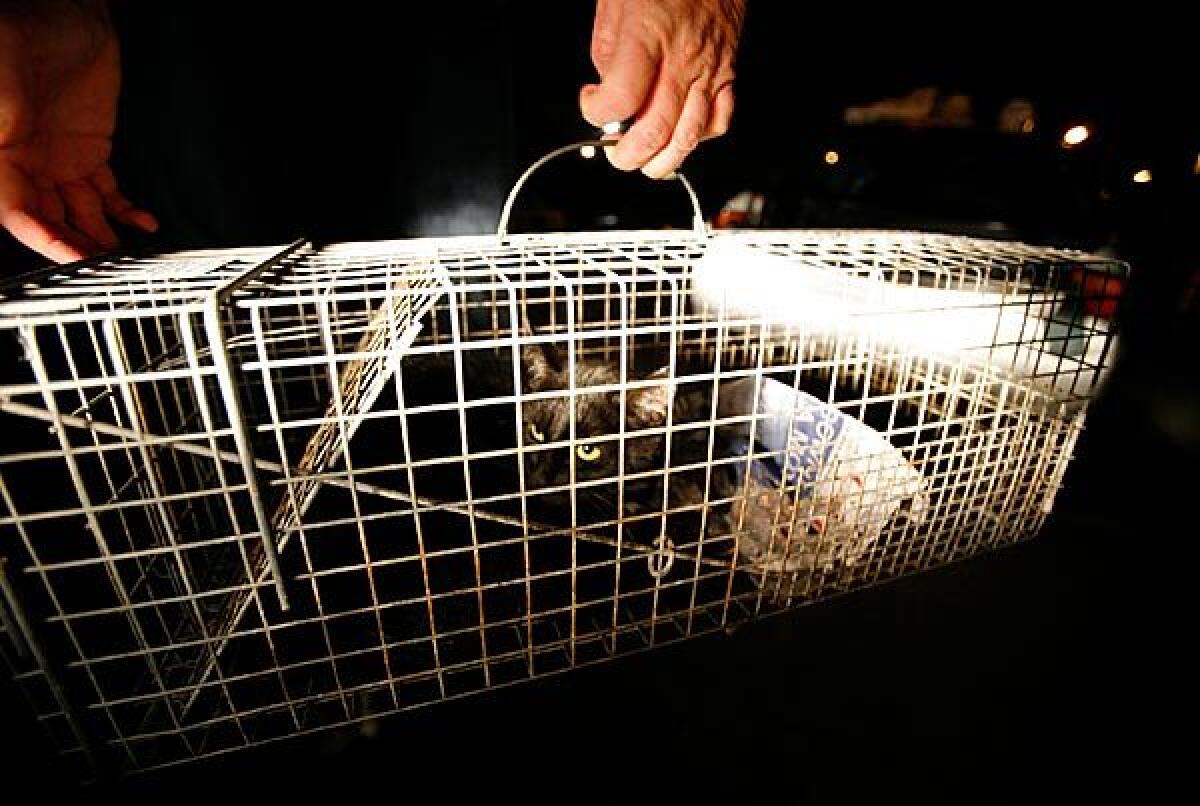Opinion: U.S. cities are overrun with feral cats, and magical thinking isn’t the solution

The alleys, parks and vacant lots of this country are alive with so many stray and feral cats that we don’t even know the precise number. Thirty-two million, says one estimate; triple that, another. The felines are the offspring of pets we didn’t bother to “fix,” the animals we adopted then dumped or left behind.
In the past, we called them pests and tried — brutally, unsuccessfully — to wipe them out. Today, the accepted strategy is to catch and sterilize them, then send them back outside, where they were. “Trap-neuter-release,” as the approach is called, has been hailed by the no-kill movement, which opposes routine euthanasia by animal shelters. And it has been adopted by animal control departments in more than 400 cities and counties. (Los Angeles has its own plan in the works.)
In theory, the tactic seems like an easy solution that lets us all sleep well: We don’t want these animals, but we also don’t want their blood on our hands. In reality, and as emphasized by a recent flare-up over the practices of Orange County’s public animal shelter system, it’s not that simple.
Originally, the promise of trap-neuter-release was to reduce stray and feral populations by curbing their prolific breeding — cats are fertile by six months of age and can give birth multiple times a year. But for cat populations to fall, more than 50% of the females in a given “colony,” or living group, need to be sterilized. That’s not easy, given cats’ ability to hide — and the fact that known colonies become dumping grounds for more unwanted, often unfixed, pets. As a result, herd sterilization hasn’t ever been achieved on a mass scale.
The approach has skeptics for other reasons, too. Many scientists, birders and wildlife managers oppose trap-neuter-release programs in general, noting that free-ranging cats are destructive predators, annually killing billions of birds and mammals, while also spreading diseases like toxoplasmosis.
The programs have been successful in one way, however. They have enabled shelters to sharply reduce the number of feral cats they impound, then euthanize, at a time when public shelters face immense pressure to reach a no-kill ideal, usually defined as not euthanizing any healthy or adoptable animals. An added bonus is reduced taxpayer cost: sterilizing and releasing cats costs less than housing, feeding and then killing them.
How well the cats themselves fare is less clear than you might imagine. Contrary to popular belief, cats are not self-sustaining. That means colonies under the watchful eye of caretakers willing to devote considerable time and money to their welfare may thrive. Those without human guardians may suffer from malnutrition, infection and parasites. Some of the cats get hit by cars or eaten by coyotes. Even the authors of a paper lauding trap-neuter-release programs acknowledged that “the welfare outcome for cats returned to location of origin were not tracked ... [and] little research on this topic could be found.”
Some shelters run neuter-and-return programs in which individual strays that are brought in by concerned residents aren’t put up for adoption, but rather are neutered and returned to where they were initially found. In October, a lawyer representing a group of animal rescues and individuals sent Orange County Animal Care, the county’s government-run shelter network, a demand that it stop its practice of “abandoning” these cats.
According to signatory Sharon Logan, some of the more than 1,000 cats Orange County released between September 2018 and June 2019 weren’t feral, but roaming, lost or abandoned pets, or kittens still young enough to be socialized and made adoptable. Some were sick, she said, and in many cases, communities where the cats were returned weren’t told the felines were coming. There was often “no obvious presence of a feeder or caretaker.” As a result, she said, the animals suffered. Carol Barnes, another signatory to the letter, shared photos of one cat she said was released by Orange County and later found malnourished, with broken ribs, an upper respiratory infection and an injured eye crawling with maggots.
An Orange County Animal Care representative declined to comment, but a research and policy analyst for Best Friends Animal Society, which runs similar programs, has called some of the critics’ claims “misinformation and scaremongering.”
The answer? No one who’s ever loved a house cat or felt moved to feed a hungry feral (that includes me) wants to return to mass killing. And well-run trap-neuter-release programs may be an important part of dealing with our national cat problem. But increased and organized efforts to educate humans about their responsibilities to their animals are also crucial. So is more rigorous enforcement of existing spay/neuter laws and far more access to affordable services.
Maybe most of all, we need to abandon what one cat lover described to me as “magical thinking” — pretending that the only thing that matters is keeping stray cats alive; believing that any one effort holds a simple, painless solution. These fictions serve mostly to comfort those responsible for our cat problem in the first place. That is, us.
Carol Mithers is a Los Angeles journalist and coauthor, with Leymah Gbowee, of the memoir “Mighty Be Our Powers: How Sisterhood, Prayer, and Sex Changed a Nation at War.”
More to Read
A cure for the common opinion
Get thought-provoking perspectives with our weekly newsletter.
You may occasionally receive promotional content from the Los Angeles Times.





